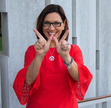Guest review: The Year the Maps Changed
[image error]The Year the Maps Changed was written by Danielle Binks Published by
Hachette Australia (2020). Historical fiction (for a middle grade readership).
Reviewed by Laura Pettenuzzo. Laura (she/her) is a writer of short stories and book reviews and is working on several novels with themes of mental health and family. She is living on Wurundjeri land. You can read her book reviews here and follow her on Twitter here.”
***
“Sorrento, Victoria, 1999. Fred’s family is a mess. Her mother died when she was six and she’s been raised by her Pop and adoptive father, Luca, ever since. But now Pop’s had to go away, and Luca’s girlfriend Anika and her son have moved in. More and more it feels like a land-grab for family and Fred is the one being left off the map.
Even as things feel like they’re spinning out of control for Fred, a crisis from the other side of the world comes crashing in. When a group of Kosovar-Albanian refugees are brought to a government ‘safe haven’ not far from Sorrento, their fate becomes intertwined with the lives of Fred and her family in ways that no one could have expected.”
Danielle Binks was one of the first names I heard when I dived into the Australian literary landscape a few years ago, and her eagerly anticipated first novel was as exquisite as I’d been expecting.
Although I’ve lived in Australia for my whole life, there’s so much about our history that I just don’t know. Usually, I’m trying to rectify the gaps in my knowledge about the rich culture of Indigenous Australia, but The Year the Maps Changed revealed another disturbing part of our past, of which I’d been unaware.
Racism is an unfortunate part of life in Australia, and with Fred’s young voice as a vehicle, Danielle Binks condemned the perpetrators and celebrated kindness, love and acceptance. There was also a mention of accessibility, when one of the refugees at the ‘safe haven’ couldn’t use the bathroom because the door wasn’t wide enough for her wheelchair. Intersectionality is everywhere, and inaccessibility and racism are everyone’s problem, not just disabled people or people of colour.
Diversity was an unquestionable part of Fred’s existence. Fred’s neighbour and best friend, Jed, was from Vietnam, and I adored how Vietnamese words, names and cuisine were woven seamlessly into the narrative. However, the father of one of Fred’s friends, Aidan, represented the racist attitudes that some people continue to hold. He voiced his disapproval of the Kosovar-Albanian refugees’ presence in Australia and Aidan was placed in the tricky situation of having to “be his own compass.” A young boy had to choose between what he knew was right and what his family believed, a predicament that felt far too familiar to me.
Small details of the story added up to create a nostalgic setting for readers who were alive in the 90’s and a brand new one for younger readers. Fred’s social life was dominated not by mobile devices and instant messages, but by outdoor adventures and an intimate knowledge of her neighbourhood and the people in it.
Place is an integral part of the novel, something I’ve rarely seen in middle grade novels. Not only was there a reverence for Sorrento and the surrounding areas, there was also, from the very first page, an acknowledgement that Australia always was and always will be Aboriginal land. I learnt that the Boon Wurrung people called the nearby mountain range Wonga, a fact that may be unfamiliar to other readers as well. The recurring image of maps and how they could lie showed Fred, and readers, that she could make her own map and was not defined by arbitrary borders or divisions. Arthurs Seat appeared several times and brought the plot and characters full circle: when Fred and her stepbrother, Sam, first rode together, Fred was angry and resentful. A year later, she was describing the landscape for Sam so that he could see what she did, even as he had his eyes shut.
My favourite line was: “This is how the world heals…One small act at a time.”
The Year the Maps Changed is an insightful novel, full of nuggets of wisdom and relatable characters, suitable for readers young and old.
You can purchase the book from independent store Farrells (which appeared in the novel!) here.



